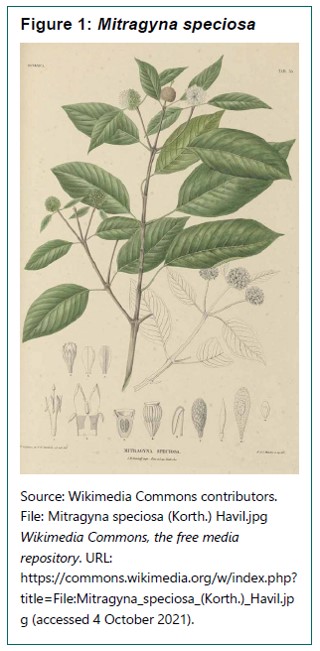Published: 2 December 2021
Publications
Kratom – not such a nice cup of tea
Published: 2 December 2021
Prescriber Update 42(4): 52–53
December 2021
 A
case has been reported to the Centre for Adverse Reactions Monitoring
(CARM) where the individual developed a hepatic reaction in relation
to use of kratom.
A
case has been reported to the Centre for Adverse Reactions Monitoring
(CARM) where the individual developed a hepatic reaction in relation
to use of kratom.
What is kratom?
Kratom is a herbal substance made from the leaves of a tropical evergreen tree (Mitragyna speciosa or kratom tree – Figure 1), which belongs to the coffee family.1 This tree is indigenous to South East Asia, the Philippines, New Guinea and parts of Africa but also cultivated elsewhere.1–3 The main active alkaloid substances in kratom are called mitragynine and 7-hydroxymitragynine (7-HMG).3
Use and misuse of kratom1
Extracts from the leaves of the kratom tree have shown psychotropic (mind-altering) and opioid-like activity and kratom has been used in traditional medicine to treat chronic pain and diarrhoea, increase energy and stamina and as a substitute for opium or for opium withdrawal. In many countries in Southeast Asia, chewing Mitragyna speciosa leaves is a common practice. However, kratom has not been shown to have any beneficial medical uses. Instead, these effects of kratom leaves have led to their use and misuse as a recreational drug. Regular kratom use can be addictive and result in adverse reactions.
Effects and side effects
The plant’s dark green leaves are usually dried and either crushed or powdered and turned into a paste, capsules, tablets or brewed as a tea. In general, the effects of kratom in humans are dose-dependent: small doses produce ‘cocaine-like’ stimulation, while larger dosages cause ‘morphine-like’ sedative-narcotic effects.2,3 Higher doses can cause agitation, hypertension, psychosis, respiratory depression, seizures, depression and confusion, and overdoses can be fatal, especially if kratom is used together with other potent substances.1,4
Chronic use of kratom recreationally has in rare cases been associated with acute liver injury.1 Onset of injury was within 1 to 8 weeks of starting regular use of kratom powder or tablets, with symptoms of fatigue, nausea, pruritus, and dark urine followed by jaundice. The liver injury was cholestatic or mixed, sometimes severe, and complicated by acute renal failure and bone marrow toxicity. Recovery usually occurred if kratom was stopped.
Regulation of kratom
Kratom use is prohibited in many countries and parts of the United States.3,5 In New Zealand, Mitragyna speciosa is classified as a prescription medicine to control use, and it is prohibited to be used in herbal remedies under section 2 of the Medicines Act 1981. Kratom is not approved for any kind of medical use or allowed in dietary supplements.
As Medsafe does not monitor the safety or purity of herbal substances unless they are in an application for approval of a medicine, there is no quality control over any kratom that may be imported in unapproved medicines (which includes herbal products).
As for all herbal products, kratom products may be of poor quality, may be sub or super potent, contaminated, adulterated or counterfeit, and its use can put people at serious risk of unpredictable or severe adverse reactions.
Imported kratom for personal use that is detected at the border is referred to Medsafe and can only be released on the authority (and responsibility) of a medical practitioner.
References
- LiverTox: Clinical and Research Information on Drug-Induced Liver Injury. 2020. Kratom. Bethesda, MD: National Institute of Diabetes and Digestive and Kidney Diseases. 3 April 2020. URL: ncbi.nlm.nih.gov/books/NBK548231/ (accessed 4 October 2021).
- European Monitoring Centre for Drugs and Drug Addiction. Kratom Drug Profile. URL: emcdda.europa.eu/publications/drug-profiles/kratom (accessed 4 October 2021).
- Warner ML, Kaufman NC, Grundmann O. 2016. The pharmacology and toxicology of kratom: from traditional herb to drug of abuse. International Journal of Legal Medicine 130(1): 127–38. DOI: 10.1007/s00414-015-1279-y (accessed 4 October 2021).
- Sevarino KA. 2020. Medically supervised opioid withdrawal during treatment for addiction. In: UpToDate 18 August 2020. URL: uptodate.com/contents/medically-supervised-opioid-withdrawal-during-treatment-for-addiction (accessed 4 October 2021).
- World Health Organization. 2021. Pre-review report: Kratom (Mytragyna speciosa), mitragynine, and 7-hydroxymitragynine. Expert Committee on Drug Dependence, 44th meeting, Geneva 11–15 October 2021. URL: cdn.who.int/media/docs/default-source/2021-dha-docs/unedited--advance-copy-44th-ecdd-review-report_kratom.pdf (accessed 3 November 2021).





